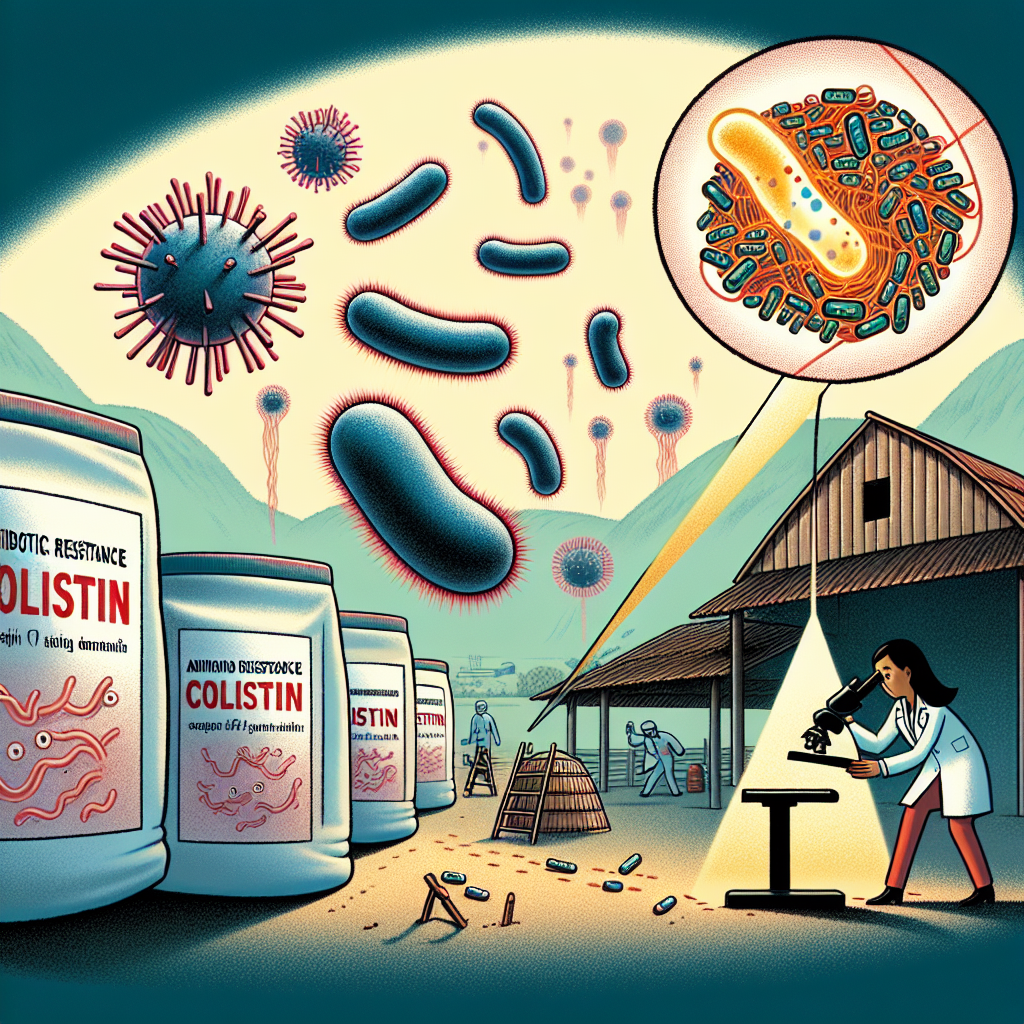Colistin use in animal feed is fueling antibiotic resistance in humans. How can we protect both animal welfare and human health?

Consider a scenario in which animal health management is jeopardized by the abuse of one of humanity’s most potent antibiotics. This is the developing reality due to the overuse of colistin in animal feed. Colistin, a last-resort antibiotic for multidrug-resistant human illnesses, is often used to prevent sickness and enhance animal growth, notably dairy cattle. Research conducted by the University of Oxford and the University of Agriculture, Faisalabad, demonstrates an alarming increase of colistin-resistant E. coli in the environment and cattle. The abuse of human antibiotics in animal feed contributes to worldwide antibiotic resistance, jeopardizing consumer health and market viability. We must end this practice and implement improved hygiene standards and alternative growth alternatives to protect dairy farming and public health. Learn about options for reducing antibiotic usage in cattle and ensuring a sustainable future for dairy production.
Resurfacing of Colistin: The Critical Last-Resort Antibiotic
Colistin, commonly known as polymyxin E, is an antibiotic that has gained popularity owing to its ability to treat multidrug-resistant Gram-negative bacteria. It was discovered in the late 1940s, but its usage in human medicine has declined dramatically as less harmful alternatives have become available. However, with the increase in antibiotic-resistant infections in recent decades, colistin has resurfaced as a crucial last-resort therapy, especially for severe conditions like pneumonia. The value of colistin in human medicine cannot be emphasized. As healthcare facilities battle with rising antibiotic resistance, colistin remains one of the only viable treatments for otherwise incurable bacterial illnesses. Recognizing its crucial significance, the World Health Organization has designated colistin as a critically important antibiotic. This classification emphasizes the need to maintain effectiveness via tight regulatory mechanisms governing its usage in human healthcare and other industries like agriculture.
Global Synergy to Combat Antibiotic Resistance
The study is a significant international collaboration among a network of prestigious institutions, including the University of Oxford in the United Kingdom, the University of Agriculture in Faisalabad, the National Institute of Health in Pakistan, Ahmadu Bello University in Nigeria, Dhaka Medical College Hospital in Bangladesh, and Cardiff University. This vast collaboration demonstrates a concerted effort to address the rising problem of antibiotic resistance across several geographic locations. The study presents solid evidence of the widespread use of colistin in agricultural techniques in low- and middle-income nations, including Pakistan, Nigeria, and Bangladesh. A key result is that, despite prohibiting colistin usage in domestic agriculture, high-income countries continue to export this crucial antibiotic to places where it remains the primary choice owing to prohibitive prices or restricted access to other therapies. This practice dramatically contributes to the increasing frequency of colistin-resistant E. coli bacteria in the environment and cattle, presenting a danger to world health.
Escalating Resistance in Pakistan: A Stark Reality
The researchers used a systematic technique to collect and evaluate samples from diverse environmental sources and cattle in Pakistan. Their results indicated an alarming presence of colistin-resistant E. coli in 7% of the samples analyzed. This statistic compares sharply with the worldwide average of 4.7%, indicating a considerable departure pointing to a more severe resistance problem in Pakistan.
The samples from the natural environment and animals raised for food demonstrated the extensive prevalence of colistin resistance and its progression to human isolates. This highlights a disturbing trend, indicating that the widespread use of colistin in animal feed contributes to the rise in resistance reported in bacterial strains impacting human populations.
A Grim Prognosis: Colistin’s Agricultural Use Threatens Human Health
The growing use of colistin in animal feed is a problematic agricultural practice that presents a considerable risk to human health. Colistin-resistant bacteria in animals and the environment serve as reservoirs, allowing the transmission of resistance genes to pathogenic bacteria that infect people. The research emphasized This concerning trend, which found a stunning 7% prevalence rate of colistin-resistant E. coli in Pakistan’s livestock and environment, compared to a worldwide average of 4.7%. More dangerously, similar resistance characteristics are identified in human isolates, indicating that agricultural usage of colistin directly contributes to the erosion of its effectiveness in treating human illnesses. Antibiotic resistance is becoming more prevalent due to the ease with which resistant genes such as mcr-1 and mcr-2 propagate across multiple vectors, including water and food supply networks. While colistin remains a last-resort antibiotic for multidrug-resistant infections, its declining efficacy severely restricts treatment choices, creating a serious public health concern.
Expert Insights: Navigating the Complex Terrain of Antibiotic Resistance
Expert comments from prominent researchers offer insight into the growing problem of antibiotic resistance and suggest mitigating strategies. Professor Timothy Walsh, Research Director of the Ineos Oxford Institute for Antimicrobial Research, explains the contradiction many high-income nations experience. The use of human antibiotics in animal feed is one of the leading causes of antibiotic resistance worldwide. While many high-income nations have decreased their use of antibiotics in agriculture, they continue to sell medications such as colistin to low- and middle-income countries, he says. He emphasizes the urgent need for efforts to end human-critical antibiotics in agriculture, adding, “We need to stop using human antibiotics for animal feeds.” However, without other options, such a prohibition would result in lower meat output, higher prices, and a loss of revenue for farmers. Therefore, enhanced farm cleanliness and animal care are recommended as interim remedies.
Dr. Mashkoor Mohsin of the University of Agriculture, Faisalabad, shares similar concerns and calls for a radical change in antibiotic treatment. He believes we must modify how antibiotics are manufactured, traded, licensed, and used in veterinary medicine. He emphasizes combining public health objectives with farmer livelihoods: “At the same time, we cannot ignore animal welfare or farmer welfare in countries such as Pakistan and Bangladesh.” Such a worldwide transformation would need significant commitment from national governments, financial institutions, pharmaceutical corporations, and international trade authorities, indicating the multidimensional effort necessary to solve this critical problem.
Regulatory Gaps and Global Trade: Fueling Colistin Resistance in Low- and Middle-Income Countries
The extensive usage of colistin in low- and middle-income nations is due to severe regulatory and trade concerns. While high-income countries have banned colistin from agriculture, they continue to export it to countries with looser restrictions, undercutting global efforts to combat antibiotic resistance. This regulatory void in Pakistan, Nigeria, and Bangladesh allows for substantial colistin usage in animal feed, which promotes colistin-resistant microorganisms. These strains may spread to people by meat intake, direct contact, or the environment.
Colistin is often overused due to a lack of sufficient control, and it is even promoted for pediatric usage under false labeling such as ‘Antibiotic—Antidiarrheal.’ Addressing this problem requires international collaboration and robust national frameworks for controlling antibiotic use in agriculture. Improving trade restrictions to prevent colistin shipments to nations with lax safeguards is critical. Improved monitoring and instructional programs for farms may encourage improved antibiotic stewardship practices.
Failure to solve these regulatory loopholes increases the risk of untreatable infections, endangering millions of lives and damaging modern medicine’s accomplishments. A worldwide effort to bridge these gaps is critical to protecting human and animal health.
Charting a Path Forward: Actionable Solutions to Curb Colistin Resistance in Animal Agriculture
The research provides numerous practical suggestions for combating antibiotic resistance caused by colistin usage in animal feed. To begin, there is an urgent need to develop and employ new medications purely for animal feed, with human antibiotics reserved for emergencies. Researchers urge financial and technical assistance to farmers in adopting improved hygiene and welfare measures, lowering their dependency on human antibiotics. Improved agricultural hygiene is critical; cleanliness may help avoid illnesses and minimize antibiotic usage. To naturally prevent disease transmission, extensive agricultural management methods are required.
International collaboration and strict regulatory frameworks are also necessary. The report emphasizes the need for coordinated actions from national governments, financial institutions, pharmaceutical corporations, and global trade authorities. Unified policies and incentives, particularly in low- and middle-income nations, are critical for addressing this public health concern.
The Bottom Line
The widespread use of colistin in animal feed aggravates antibiotic resistance, presenting hazards to cattle and humans. Colistin, critical for treating multidrug-resistant diseases in people, is being overused in agriculture, especially in low- and middle-income nations, compromising its efficacy. The research identifies a concerning rise of colistin-resistant E. coli in habitats and food animals, particularly in Pakistan, which mirrors comparable human health issues.
Key results highlight the need for stringent restrictions and viable alternatives in animal agriculture. Many farmers are unaware of the hazards of using human-critical antibiotics for animals, emphasizing the need for education and assistance. The report advocates for a worldwide effort by governments, pharmaceutical corporations, financial institutions, and international authorities to reform antibiotic production, trade, and usage. Antibiotic resistance must be addressed as a communal effort.
Developing alternative livestock medications, improving farm cleanliness, and implementing sustainable animal care methods are critical. Your involvement as a dairy farmer is crucial. Our determined and responsible efforts will determine whether or not we live in a future free of the devastating repercussions of antibiotic resistance.
Key Takeaways:
- Colistin, a last-resort antibiotic for multidrug-resistant infections in humans, is increasingly used in animal agriculture.
- Despite bans in some high-income countries, colistin is still exported to low- and middle-income countries where regulatory oversight is weak.
- The study identified a higher prevalence of colistin-resistant E. coli in food animals and the environment in Pakistan, with resistance observed in 7% of samples, exceeding the global average of 4.7%.
- Farmers in low-income countries often lack awareness of the consequences of using human antibiotics in animal feed, leading to widespread misuse.
- Researchers emphasize the need for new, animal-specific antibiotics and improved farming practices to reduce reliance on critical human antibiotics like colistin.
Summary:
The overuse of colistin in animal feed is a growing concern due to its potential to cause antibiotic resistance. Colistin, a last-resort antibiotic for multidrug-resistant human illnesses, is often used to prevent sickness and enhance animal growth, particularly in dairy cattle. However, research by the University of Oxford and the University of Agriculture, Faisalabad, shows an alarming increase of colistin-resistant E. coli in the environment and cattle, contributing to worldwide antibiotic resistance. Colistin, also known as polymyxin E, has gained popularity due to its ability to treat multidrug-resistant Gram-negative bacteria. The World Health Organization has designated colistin as a critically important antibiotic, emphasizing the need for tight regulatory mechanisms governing its usage in human healthcare and other industries like agriculture. A significant international collaboration among prestigious institutions has been conducted to address the rising problem of antibiotic resistance across several geographic locations. High-income countries continue to export colistin to places where it remains the primary choice due to prohibitive prices or restricted access to other therapies. Experts like Professor Timothy Walsh and Dr. Mashkoor Mohsin have provided insights into the growing issue and suggest strategies to combat it, including efforts to end human-critical antibiotics in agriculture and a radical change in antibiotic treatment.











